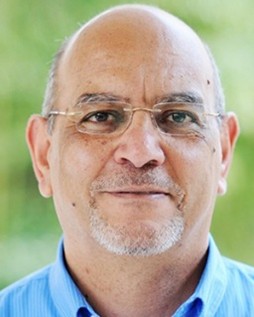
Hussein Mohamed
Professor of Biology School of Arts and Sciences Department of Life ScienceOffice
Peeples Hall 218
Academic Degrees:
Doctor of Philosophy in Botany (Plant Biology), 1992. The University of Alexandria, Egypt, and Eberhard Karls University, Tübingen, Germany. 1992
Master of Science in Botany (Plant Biology), The University of Alexandria, Egypt. 1986
Bachelor of Science in Biology – Botany, University of Alexandria, Egypt. 1981
Academic Appointments and Work Experience
Professor of Biology, Dalton State College, Department of Life Science, School of Arts and Sciences, Dalton, GA, 2014-Present.
Faculty Senate President. Dalton State College. 2022-2024.
Adjunct Faculty, University of Tampa, Biology Department, Tampa, FL, 2007-2014.
Adjunct Faculty, Hillsborough Community College, Tampa, FL, 2007-2014.
Postgraduate Researcher, Earth & Environ Sci Dept, The University of Texas at San Antonio, TX, 2004-2005
Postgraduate Researcher, Dept Plant & Microbial Biology, The University of California, Berkeley, CA, 2000-2003.
Assistant Professor of Plant Biology, Alexandria University, Department of Environmental Sciences, Egypt, 1992-2000.
Ph.D. Scholar. Deutscher Academischer Austauschdienst, Eberhard Karls University, Tübingen, Germany,1989-1992.
Instructor of Plant Biology, Alexandria University, Botany Dept. Egypt, 1981-1989.
Teaching
Bioremediation (BIOL 4725)
Ecology (BIOL 3500)
Plant Biology (BIOL 3510),
Botany (BIOL 1203)
Cellular Biology (BIOL 1107)
Organismal Biology (BIOL 1108)
Environmental Studies. (BIOL 1105)
Research
My research is highly diverse and focuses on plant-habitat interactions, particularly the ecology of plants in extreme environments, My research is employing innovative combinations of laboratory, field, and theoretical approaches to select the suitable phytoremediation technique to clean up the contaminated sites and assess the influence of anthropogenic perturbations to identify the molecular and biochemical mechanisms responsible for plant coexistence with the surrounding environment.
Professional Research Activities:
- A novel phytoremediation method using vetiver grass to clean up lead-based paint-contaminated Funded by the US Department of Housing and Urban Development and the University of Texas at San Antonio.
- Optimization of plant-microbial treatment systems for the phytoremediation of PAH-contaminated soils and Funded by Electric Power Research Institute, Inc. (EPRI) and the University of California at Berkeley.
- Environmental acceptability of the integrated on-farm drainage management system (IFDM). Funded by California State Water Resources Control Board, Division of Water Quality, and the University of California at
- Phytoremediation of Organomercurial Compounds via Chloroplast Genetic Collaborative research project between the Department of Plant and Microbial Biology (Berkeley, CA) and the Department of Molecular Biology and Microbiology, University of Central Florida (Orlando, Florida). The outstanding achievement of this study is, for the first time, the successful overexpansion of bacterial genes into the chloroplast genome of tobacco plants.
- Plant-growth-promoting bacteria (PGPR), Pseudomonas, to improve polycyclic aromatic hydrocarbon (PAH) Funded by the US Civilian Research & Development Foundation (CRDF) and the University of California at Berkeley.
- Development of Plant-Microbe Interactions for the Phytoremediation of Heavy Metals in Contaminated Funded by NSF (USA), Egypt Joint Science and Technology Board, and the University of California at Berkeley.
- The fate of selenium in constructed wetlands treating agricultural drainage water: Role of sediment Se deposition and Se Funded by UC Center for Water Resources, UC Salinity/Drainage Program, and the University of California at Berkeley.
- Socio-Economic Dimension of Environmental Degradation in Rural Areas of Lower Funded by Egyptian MAB National Committee (UNESCO National Commission), the Ford Foundation- USA.
- Systems research for integrated resource management and land use analysis in the Mediterranean Coastal Desert of Funded by: The Center of Agrobiological Research (CABO), Wageningen, Netherlands.
- Regional Environmental Management of Desert Ecosystems of Northern Funded by the Egyptian Academy of Science and Technology, UNESCO, and the U.S./Environmental Protection Agency.
Publications (Peer-Reviewed Journals, Books, And Conference Proceedings)
- Allmon A, Mohamed H. Morphological and Physiological Comparisons between Yellow Toadflax (Linaria vulgaris) Individuals Exposed to 2,4-Dichlorophenoxyacetic Acid (2,4-D). J Tissue Cult Bio Bioeng, Online Access 2018.
- Alexander Allmon and Hussein Mohamed. Examining the clonal development of yellow toadflax, Linaria vulgaris in response to the herbicide 2,4-D exposure. Association of Southeastern Biologists, 78 Annual Meeting. Montgomery. Alabama 2017.
- -Q. Lin, N. Terry, S. Gao, H. Hussein, Z.H. Ye. Vegetation changes and portioning of selenium in 4-year-old constructed wetlands treating agricultural drainage. International Journal of Phytoremediation. 12: 3, 255- 267, 2010.
- Hussein. Optimization of Plant-Bacteria complex for phytoremediation of contaminated soil. International Journal of Botany, 4(4): 437-443, 2008.
- Hussein, Oscar N.R., Daniell H., Terry N. Phytoremediation of mercury and organomercurials in chloroplast transgenic plants: Enhanced root uptake, translocation to shoots and volatilization. Environmental Science and Technology, 41: 8439- 8446, 2007.
- -Q. Lin, H. Hussein, Z. H. Ye, N. Terry. Phytorestoration of metal-contaminated industrial wasteland: a greenhouse feasibility study. In: Concepts and Applications in Environmental Geochemistry. Developments in Environmental Science, D. Sarkar, R. Datta and R. Hannigan (Editors). Volume 5. Chapter 25: 545-561. Elsevier, 2007.
- Datta R., Sarkar D., Hussein H. and Therapong C. Remediation of arsenical pesticide applied soils using water treatment residuals: Preliminary greenhouse results. In: Concepts and Applications in Environmental Geochemistry. Developments in Environmental Science, D. Sarkar, R. Datta and R. Hannigan (Editors). Volume 5. Chapter 22: 487-501. Elsevier, 2007.
- Anna E. Tryfonas, John K. Tucker, Paul E. Brunkow, Kevin A. Johnson, Hussein H, Zhi-Qing Lin. Metal Accumulation in Eggs of the Red-eared Slider (Trachemys scripta elegans) in the Lower Illinois River. Chemosphere 63(1): 39-48, 2006.
- Mohamed, Hussein, Therapong, C., Andra, S., Datta, R., and Sarkar, D. Phytoavailability of Arsenic in pesticide-Applied Soils: Effect of Chemical Remediation. Oral Presentation in the Symposium: Pollutants in Lotic Systems – III in the 2005 Joint Assembly of the AGU, SEG, NABS and SPD/AAS, New Orleans, LA, May 23-27, 2005.
- Oscar N.R., Hussein S., Terry N., Daniell H. Phytoremediation of Organomercurial Compounds via Chloroplast Genetic Engineering. Plant Physiology, 132(3). 1344-1352, 2003.
- -Q. Lin, H. Hussein, A. Tagmount, A. Lee, and N. Terry. Pickleweed: A Novel Species for Phytoremediation of Se Contamination. 7th International Conference on the Biogeochemistry of Trace Elements: ICOBTE, 15-19 June 2003, SLU, Uppsala, Sweden, 2003.
- Fox, P.M., D.L. LeDuc, H. Hussein, Z.-Q. Lin and N. Terry. Selenium speciation in soils and plants. In: Y. Cai and OC Braids (eds). Biogeochemistry of Environmentally Important Trace Elements. American Chemical Society, Washington DC. Series 835: 339-354, 2003.
- Hussein, H.S. and Terry N. Phytomonitoring the unique colonization of oil-contaminated saline environment by Limoniastrum monopetalum (L.) Boiss. In Egypt. Environment International, 2002, 28:127-135, 2002.
- Kamal, S. A. and Hussein, H.S. Vegetative Analysis of Jabel Manzour, Northern Sinai, Egypt. VIth National Conference for Environmental Studies & Research. Ain Shams University, Cairo – Egypt. 7-9 November 1999. Pp. 85-107, 1999.
- Hussein, H.S. Optimization of callus formation and induction of suspension culture from Cajanus cajan (L.) Mllsp. Journal of Union of Arab Biologists. Vol. 7(b) 1999, 277-288, 1999.
- Hussein, H.S. Effect of metabolite accumulation on environmental stress tolerance in Thymelaea articulata deserts species. Bulletin of the Faculty of Science, Assiut Univ., 1999, vol. 28: 63-76, 1999.
- El-Darier, S.M. and Hussein, H.S. Comparative allocation of biomass and nutrients in Panceratium maritimum VI National Conference for Environmental Studies & Research. Ain Shams University, Cairo – Egypt. 7-9 November 1999. Pp. 109-126, 1999.
- Hussein, H.S. and Yossef, R. Metabolic Response in Some Desert Species to Physiographic Variations. Desert Inst. Bull. 1997, 47 No.2: 455-470, 1997.
- Hussein, H.S. Evaluation of undergraduate curriculum at the department of environmental science, Alexandria University, Egypt. Towards a Shared Vision for Higher Education. Amini, S; Fremerey, M & Wesseler, M (Eds.). Institute for Social-Cultural Studies. University of Kassel. Germany. 139-152, 1997.
- Hussein, H.S. Effect of Salt Stress on Callus Culture of Carob (Ceratonia Siliqua ) Fruit Tree. Journal of Union of Arab Biologists.1 (B): 129-147, 1994.
- Fawzy, M.A. and Hussein, H.S. Seasonal Variations in Species Diversity Pattern at the Mediterranean Coastal Desert of Journal of Union of Arab Biologists. 1:163-182, 1994
- Hussein, H.S. and Wegmann, K. Salinity Tolerance in Two Fruit Tree Cultures: Effect of Exogenous Proline Application to the Culture Medium. First Egyptian-Hungarian Conference on Environment 1993, St. Catherine, Sinai, Egypt, 1993.
Grants
- Dalton State Foundation. Campus Enrichment Grants: 2017-2020.
- Project Title: Assessment of Physical and Environmental Properties for Sustainable Crop Production Using Field Methods and Geographic Information Systems.
- Project Title: Cutaneous antibacterial effects of plant-derived essential oils
- U.S. Department of Education Title III, STEM IV: Grants 2021-2022.
- Project Title: Selection of Salt and Drought Tolerant Cell Lines of Trifolium repens (white clover) using Tissue Culture Techniques.
- Project Title: Phytoremediation of Arsenic (III) Oxide and Sodium Arsenate with Vetiveria Zizanioides.
- Project Title: Resources Allocation of Linaria Vulgaris (Yellow Toadflax) As Response of Herbicide Application.
- Project Title: Morphological and Physiological Comparisons between Yellow Toadflax (Linaria vulgaris) Individuals Exposed to 2,4-Dichlorophenoxyacetic Acid (2,4-D).
- Project Title: Dirt Free Farming; Feeding a growing population through hydroponics.
- U.S. Department of Education Title III, HIS Grants: (2022-present)
- Project Title: Tissue Culture vs Hydroponics as a Small-Scale Tobacco Production for phytoremediation.
- Project Title: Selection of heavy metal hyperaccumulation cell lines using tissue culture techniques as a tool of phytoremediation of heavy metal-contaminated ecosystems.
- Project Title: Phytoremediation of Selenium by Vetiver grass in a hydroponic system.
- Project Title: Selection of salt and drought-tolerant cell lines of Tobacco using tissue culture techniques.
- Project Title: Optimization Of Ethanol Levels in the commonly used herbal species as an efficient source of renewable biofuel.
- Course-embedded Undergraduate Research Experiences (CURE) Grant Program.
- Study the decomposition rate across different climatic conditions. Spring 2025, BIOL 3500 Ecology Class.
- Screening of plants’ anti-microbial metabolites as promising inhibitors of various pathogenic bacteria. Spring 2025, BIOL 3510 Plant Biology Class.
- Study the effect of light quality on plant growth and photosynthetic performance. Fall 2024 and Spring 2025, BIOL 1203 Botany Class.
- Bioremediation of Industrial Pollution. Fall 2024, BIOL 4275 Bioremediation Class.

